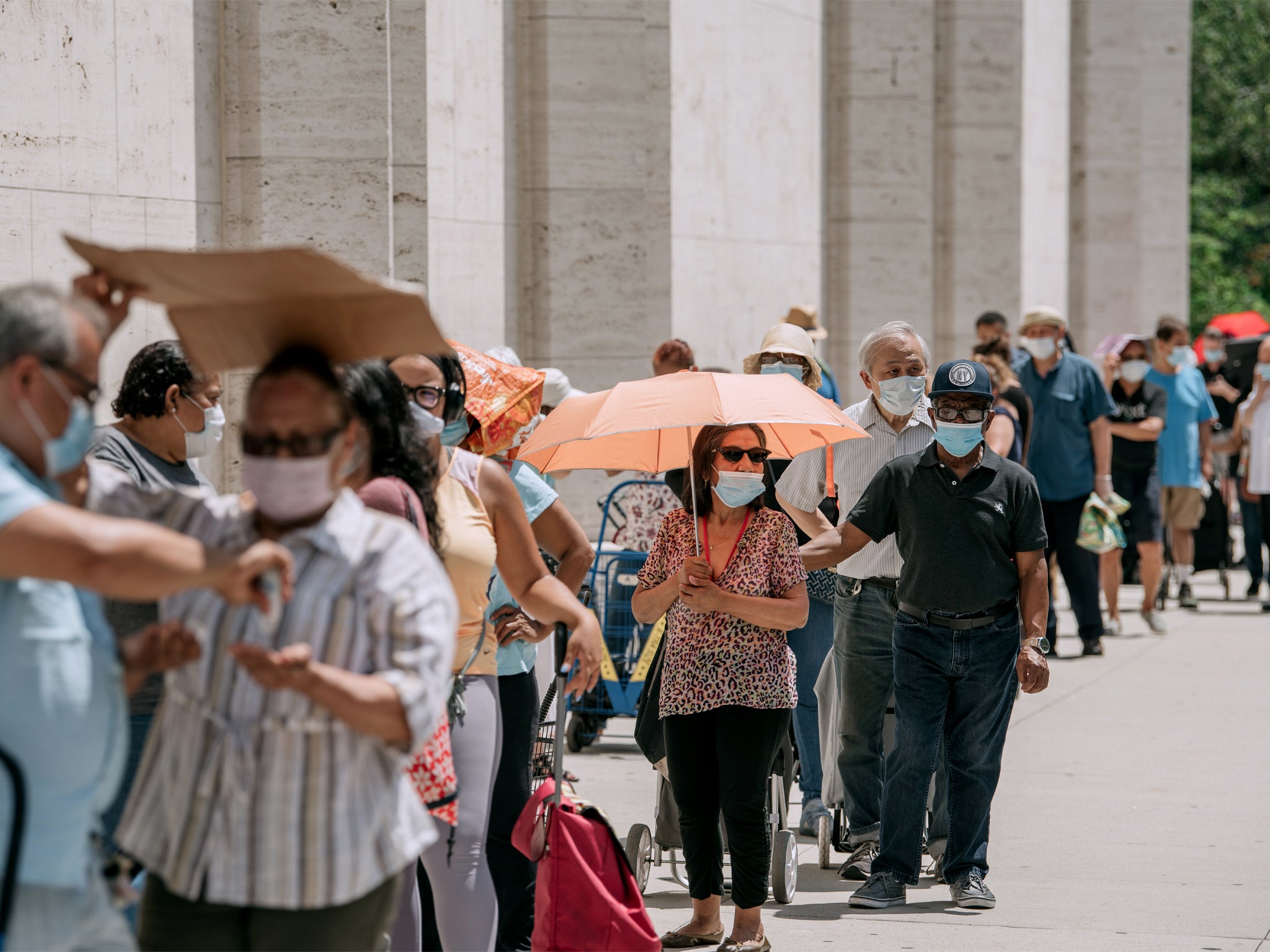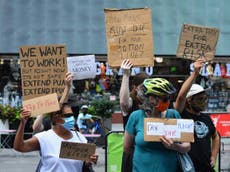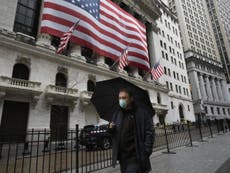Coronavirus recession is most unequal in modern US history as lower classes suffer worse
Economic collapse hitting poorer households at scale that is worst in generations

Your support helps us to tell the story
From reproductive rights to climate change to Big Tech, The Independent is on the ground when the story is developing. Whether it's investigating the financials of Elon Musk's pro-Trump PAC or producing our latest documentary, 'The A Word', which shines a light on the American women fighting for reproductive rights, we know how important it is to parse out the facts from the messaging.
At such a critical moment in US history, we need reporters on the ground. Your donation allows us to keep sending journalists to speak to both sides of the story.
The Independent is trusted by Americans across the entire political spectrum. And unlike many other quality news outlets, we choose not to lock Americans out of our reporting and analysis with paywalls. We believe quality journalism should be available to everyone, paid for by those who can afford it.
Your support makes all the difference.The economic collapse sparked by the pandemic is triggering the most unequal recession in modern US history, delivering a mild setback for those at or near the top and a depression-like blow for those at the bottom, according to a Washington Post analysis of job losses across the income spectrum.
Recessions often hit poorer households harder, but this one is doing so at a scale that is the worst in generations, the analysis shows.
While the nation overall has regained nearly half the lost jobs, several key demographic groups have recovered more slowly, including mothers of school-age children, black men, black women, Hispanic men, Asian Americans, younger Americans (ages 25 to 34) and people without college degrees.
White women, for example, have recovered 61 per cent of the jobs they lost – the most of any demographic group – while black women have recovered 34 per cent, according to Labor Department data through August. And workers with college degrees are 55 per cent recovered, compared with less than 40 per cent for workers with high school degrees.
The recession's inequality is a reflection of the coronavirus itself, which has caused more deaths in low-income communities and severely affected jobs in restaurants, hotels and entertainment venues as Americans try to avoid crowded places to protect their own health and slow the spread of the virus. Jobs in these places pay, on average, $17 (£13.16) an hour and were mostly held by women and people of colour.
No other recession in modern history has so pummelled society's most vulnerable. The Great Recession of 2008 and 2009 caused similar job losses across the income spectrum as Wall Street bankers and other white-collar workers were handed pink slips alongside factory and restaurant workers. The 2001 recession was more unequal than the Great Recession: After the 9/11 terrorist attacks, travel and tourism jobs vanished and low-wage employment fell seven per cent below the previous year's level, while high earners remained largely unscathed. Yet, even that inequality is a blip compared with what the coronavirus inflicted on low-wage workers this year.
"It's an even more unequal recession than usual," said Ben Bernanke, who led the Federal Reserve through the Great Recession. "The sectors most deeply affected by covid disproportionately employ women, minorities and lower-income workers."
At the height of the coronavirus crisis, low-wage jobs were lost at about eight times the rate of high-wage ones, The Post found. The devastation was deepest among the lowest-paid, but middle-class jobs were not spared. A clear trend emerged: The less workers earned at their job, the more likely they were to lose work as businesses across the country closed.
By the end of the summer, the downturn was largely over for the wealthy – white-collar jobs had mostly rebounded, along with home values and stock prices. The shift to remote work strongly favoured more-educated workers, with as many as six in 10 college-educated employees working from home at the outset of the crisis, compared with about one in seven who have only high school diplomas.
Deep pain remains nearly seven months into the crisis: Employment for low-wage workers was still down more than 20 per cent in August from the summer before, and around 10 per cent for middle-wage workers.
Americans ages 20 to 24 suffered the greatest job losses, by far, of any age group when many businesses closed in the spring. College-age workers and recent graduates tend to be overrepresented in low-paying retail and restaurant jobs, which allow them to gain a toehold in the workforce and save money for school or training. While about half the jobs have returned for this age group, they still have a steep climb – roughly two million more jobs – to get back to pre-coronavirus levels. Young black workers remain the furthest behind.
In the wake of widespread closings of schools and day-care centers, mothers are struggling to return to the workforce. Mothers of children ages six to 17 saw employment fall by about a third more than fathers of children the same age, and mothers are returning to work at a much slower rate. This disparity threatens years of progress for women in the labor force.
Sierra Phillips of Columbus, Ohio, is a mother to two young children who is struggling to get back into the workforce. She lost her job nannying for two families in the spring. Her employers laid her off after they started working from home and opted to watch their own children to save money. Phillips, 25, cannot return to work until she finds suitable child care for her own children.
"I'm still kind of worried about going back to work. My youngest is 10 months and my oldest is autistic. The program my autistic child was in has not opened back up yet," said Phillips, who is African American and is getting by on her husband's salary since he kept his job at a warehouse. "I do not feel comfortable hiring a babysitter."
The unemployed are facing new challenges. Despite President Donald Trump's promises of brevity regarding the recession, 26 million people are still receiving now-diminished unemployment benefits. The unemployed went from receiving, on average, over $900 (£700.47) a week in April, May, June and July, under the first federal stimulus package, to about $600 (£466.98) for a few weeks in late August and early September under a temporary White House executive action, to about $300 (£233.49) a week now on state benefits.
The drop in aid is hurting groups that have traditionally struggled to get hired coming out of recessions. Research and historical data show that white workers and those with college degrees are typically hired first, a trend that appears to be playing out again.
What ties all of the hardest-hit groups together – low-wage workers, black workers, Hispanic men, those without college degrees and mothers with school-age children – is that they are concentrated in hotels, restaurants and other hospitality jobs.
When The Post analysed Labor Department data to understand the disparities in this recession, the group hit hardest by the crisis tended to also be the subgroup that had the most employees who worked in services.
Most recessions, including the Great Recession, have affected manufacturing and construction jobs the most, but not this time. Nine of the 10 hardest-hit industries in the coronavirus recession are services. They include performing arts, sightseeing, hotels, transportation, clothing retail and museums.
Economists worry that many of these jobs will not return, with restaurants and entertainment venues going out of business. Hospitality jobs are still down nearly 25 per cent. Even if a vaccine is developed and widely distributed, business travel might not return for years to pre-coronavirus levels, with videoconferencing increasingly becoming a more routine way of doing business for many companies.
"The writing is on the wall. I don't think my owner is going to make it," said Tiffany Burgin, an assistant manager of a restaurant in the French Quarter of New Orleans that remains closed. "It's a 100 per cent tourist-driven economy here. Until the tourists come back, we're screwed."
Burgin, 51, never got a college degree. She climbed her way up the ranks of New Orleans' booming restaurant industry, serving entrees and tending bar for years before becoming a manager. But she has not worked since mid-March, after a mass of tourists caught the coronavirus following Mardi Gras celebrations. Many establishments in the French Quarter are still boarded up.
"I get $247 (£192.24) a week in unemployment," Burgin said. "Who can live on that? Who? Nobody I know. I haven't been this poor since I was a teenager."
While the US unemployment rate has fallen to 8.4 per cent, double-digit unemployment lingers in cities and states that depend heavily on tourism. In Nevada and Hawaii, unemployment is still over 12 per cent.
Burgin wants to keep working in the restaurant industry, but more than 30,000 restaurant and hospitality workers are unemployed in New Orleans, making it nearly impossible to find a job. The city's official unemployment rate is near 12 per cent.
Burgin and her boyfriend received an eviction notice but are fighting to stay. Burgin does not know how they can find a cheaper place. Her boyfriend also lost his restaurant job. Their rent is $675 (£525.35) a month.
Ten percent of renters reported "no confidence" in their ability to pay next month's rent, according to a US Census Bureau survey conducted 2 - 14 September.
Hospitality jobs became a lifeline for workers struggling to recover from the last crisis. The US economy added 22.5 million jobs – 18.9 million in services – from 2010 until the coronavirus health emergency. The industry that added the most jobs over that time, restaurants and bars, pays the lowest wages. Restaurant servers typically make about $11 (£8.56) an hour, and cooks make about $13.40 (£10.43), with many workers living paycheck to paycheck.
People who are working again in the service sector say they are often making far less than before, especially in coronavirus hot spots, leaving these workers barely able to pay bills. Alison Detrick, 44, cleans homes in New Orleans. All her clients canceled in the spring. She slashed her prices this summer to lure some of them back.
"I'm cleaning people's homes for bargain-basement prices," said Detrick, who is African American and has invested heavily in masks, jumpsuits and shoe covers. "I used to charge $200 (£155.66) to clean a home. Now I charge $75 (£58.37)."
The reduced pay and added safety costs have left Detrick struggling to pay rent and other bills. For the first time, Detrick accepted help when a church group was offering free groceries across the street from her apartment building.
Black women are facing the largest barriers to returning to work, data shows, and have recovered 34 per cent of jobs lost in the early months of the pandemic. They are among the most likely to work in low-paying service-sector jobs, which have been slow to rebound at a time when it is still a major health risk to be around others. Nearly 30 per cent of black women work in services, compared with a fifth of White women. Black people also often face discrimination in the hiring process, research from Texas A&M University and elsewhere has shown.
It took until 2018 for black women's employment to recover from the Great Recession. Now almost all of those gains have been erased.
Natasha Smith found out from a TV news report on 15 May that she would not be returning to her job at the DiamondJacks Casino and Hotel in Louisiana. The casino announced that it was closing forever, and her boss never called to let her know. For four years, she worked there as a hotel housekeeper, inching her way up to $9.50 (£7.39) an hour with ample overtime. Now she cannot get a call back after submitting dozens of job applications.
"I have a package of chicken legs and a package of wings left in my refrigerator, and that's it," said Smith, who is African American. "I'm barely making it. I owe $170 (£132.31) on my electric bill. They sent me a cutoff notice."
A single mother, Smith, 34, of Shreveport, went from being able to pay her bills to having to beg the electric company to work with her on a payment plan. She prays daily that she will at least get a job interview and that Congress "can see how we are living" and increase the payments at least a bit. Smith currently gets $100 (£77.83) a week in unemployment benefits.
Historically, people of color and Americans with less education have been overrepresented in low-paying service jobs. Economists call it "occupational segregation."
In many cases, occupational segregation traces back to the end of slavery, when Black women were expected to work only in the lowest rungs of the service-work ladder as housekeepers and caretakers, jobs in which they remain overrepresented today, said Bucknell University economics professor Nina Banks.
"I've been doing so many job applications, but no one calls you back," said Smith, who has a 13-year-old son. "They say they are 'hiring immediately,' but when you do the application, you don't even hear back. I call and they say they'll get back to be, but they never do."
Black and Hispanic men face many of the same challenges as black women, encountering discrimination in the workforce more often than others, and they struggled to rebound from the Great Recession.
Top policymakers at the Federal Reserve have acknowledged this problem but have maintained over the years that getting the overall economy to full employment is the best way to help minorities find jobs. By 2019, African American employment hit record levels, an achievement for which Trump often took credit. This was particularly notable for Black men, who unlike other American men had not seen substantial job gains during the expansion of the early 2000s.
But that changed in this recession. The employment rate for black and Hispanic men hit its lowest level ever in April, and these workers have struggled to get their jobs back. Black men have recovered fewer than 40 per cent of jobs lost – the slowest recovery of any demographic group, other than black women. Hispanic men have recovered about 47 per cent of lost jobs.
James Barker says the best meal he gets each week now comes from a Missionary Baptist Church in downtown Chicago. Barker, who is African American, never thought he would be lining up for free meals at a church, but he lost all his work in March.
Barker, 58, is a handyman who has been running his own construction business for years. He often got calls from big commercial real estate companies in Chicago to do jobs for them, but that gig dried up, with few people working in offices now. He received his first call in months on Friday and was offered $12 (£9.34) an hour, half the rate he commanded pre-pandemic. He needed the money, so he took the handyman job, which is only for a few days.
"You don't want to cry, but sometimes you have no choice," Barker said. "People need to know how unfair this has been."
Barker says he and his wife also never received the $2,400 (£1,870) stimulus check they expected. He was also turned down for a Small Business Administration grant and loan. The couple ran down their savings and are now behind on bills.
Among the hardest-hit in this crisis, mothers also stand out. Women had logged tremendous job gains in the past decade before the pandemic. Last year, women made up more than half of the labor force for only the second time in US history.
But with many schools and child-care centers closed and the migration to online learning, many working parents have had to become part- or full-time teachers, making it difficult to work at the same time. That burden has fallen mainly on mothers, data shows. For example, mothers of children ages six to 12 – the elementary school years – have recovered fewer than 45 per cent of jobs lost, while employment of fathers of children the same age is 70 per cent back.
Single parents have faced an especially hard blow. Jessica Duke is a single mother who wakes up every day worried about having enough food for her two teens. They eat ramen noodles or SpaghettiOs on a good night. It is all they can afford on the $86 (£66.93) a week Duke receives in unemployment aid from the state of North Carolina.
Since losing her $11(£8.56)-an-hour job as a home health aid in early April, Duke said, she has lost 38 pounds from stress and lack of food. Her son keeps asking where her bowl is. She tells him she eats later, a small lie.
"I want to make sure the kids get food," Duke, 37, said from her home in Monroe, N.C. "If there's anything left in their bowls, I'll eat. I never eat before they do. I want to make sure they're full."
Duke's Nissan SUV was repossessed after she could not make the payments. Since losing her car, she has had to ask friends for rides to food banks and the grocery store, and it has severely limited her job options. One in eight households with children do not have enough to eat, according to a US Census survey conducted 2 - 14 September.
Duke received a few weeks of the $600 (£466.98) payments from the federal government, but it was used up quickly, at first by rent.
When the pandemic hit, Duke's brother, a 30-year-old welder, moved in with her family to try to help them out, picking up an extra job at a warehouse to earn more. But at the end of May he developed a nasty cough. When Duke went to wake him on 2 June, his body was cold. An autopsy confirmed he died of Covid-19, the illness caused by the novel coronavirus. Much of the rest of Duke's summer unemployment checks went to pay for his funeral.
"I'm just ready to wake up from this nightmare and have everything go back to the way it was before. But I know it won't ever be like that," said Duke, who cries when she talks about her brother. "This covid has totally ruined our lives. It took my baby brother from me."
The Federal Reserve predicts unemployment will not near pre-pandemic levels until the end of 2023. For many jobs, it may take even longer – especially those already at high risk of being replaced with software and robots.
Lei Ding and Julieth Saenz Molina of the Federal Reserve Bank of Philadelphia predict that the Covid-19 crisis will accelerate the pace of automation. For example, the Pennsylvania Turnpike sped up its plan to go cashless, eliminating more than 500 jobs at tollbooths. Hotels are using more check-in kiosks and cleaning robots.
"Since the 1980s, almost all employment losses in routine occupations, which are relatively easier to be automated, occurred during recessions," Ding and Molina wrote in a new research paper. "Automatable jobs held by minority workers were hit particularly hard by the pandemic, putting these workers who were already vulnerable in the job market at a greater risk of permanent job loss."
It took a full decade to return to full employment after the Great Recession. University of Texas economist Aysegul Sahin expects a faster recovery this time, but she fears that older workers and people who are primary caregivers of young children will struggle to return to the workforce.
Many economists and business leaders are urging Congress to enact another large relief package, especially given the unevenness of the recovery and the long road for those who have been left behind.
"There are very clear winners and losers here," said Mark Zandi, chief economist at Moody's Analytics. "The losers are just being completely crushed. If the winners fail to help bring the losers along, everyone will lose. Things feel like they are at a breaking point from a societal perspective."
The coronavirus recession is, in many ways, redefining the dividing line between the haves and have-nots in the United States. As more people who had just been getting by, like Jessica Duke in North Carolina or Natasha Smith of Shreveport, La., fall into poverty, the longer the nation's recovery will take.
The Washington Post















Join our commenting forum
Join thought-provoking conversations, follow other Independent readers and see their replies
Comments